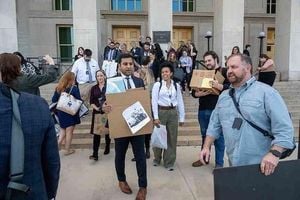For Elena Malone and her family, their dream home in Sun Valley, Los Angeles, has morphed into a formidable nightmare, courtesy of a neighbor's compulsive hoarding. What began as a picturesque retreat with sprawling green space and mountain views has been marred by piles of rusting vehicles, heaps of trash, and hazardous waste next door.
Elena, a history teacher, and her husband Josh, a math teacher, envisioned a sanctuary for their children when they purchased the house in 2021 for $1.2 million. Yet, three years later, the idyllic space has turned into what feels like a pricey prison. Their neighbor, David Ferrera, has flooded his six-acre property with more than a hundred abandoned automobiles and a multitude of waste materials. Ferrera and his girlfriend have even taken to living in a car right in front of the Malones’ home, with the street littered with everything from hypodermic needles to human excrement.
The affected residents, including Elena and Josh, have desperately sought assistance from multiple government agencies, but to little avail. Over the years, the property has attracted scrutiny from authorities, including a case where the L.A. city attorney's office took action, resulting in David Ferrera’s elderly mother being briefly jailed due to the unclean state of the property she owns. Yet, this legal turmoil hasn’t brought much-needed intervention.
The broader picture paints a grim reality for American communities, highlighting the significant impact of hoarding disorder. Recognized as a mental health condition only as recently as 2013, it affects around 2.6% of Americans. Senator Bob Casey of Pennsylvania has been raising awareness about the issue, noting that older adults are particularly vulnerable. As chair of the Senate Special Committee on Aging, Casey calls for more resources and a better understanding of this debilitating condition affecting an estimated 14 million people nationwide.
Hoarding doesn't just contribute to social isolation; it can lead to severe physical health consequences. Statistically, 70% of individuals with the disorder can't use their sofas, while 42% are unable to utilize their bathtubs. The clutter poses a significant fire hazard, further endangering lives. For example, flashover—the point where all items in a room catch fire—occurs in about one minute and forty seconds in cluttered homes, compared to six minutes in uncluttered spaces. This rapid escalation makes rescues almost impossible.
Hoarding disorder also places firefighters and rescuers at heightened risk. Often, homes of those with the disorder become unmanageable labyrinths of possessions, severely hindering efforts to save lives in emergencies.
Ferrera's own mother, Mary—a retired teacher—illustrates the deep emotional conflict that families face. While acknowledging the mess and the neighborhood's wrath, she continues to support her son emotionally, bringing him food daily and buying him some time to clean up the space. Even after being fined and facing jail time, she struggles with balancing love and enabling the detrimental behavior.
Efforts to address the disorder require patience and empathy. Experts like Florida State University's Brad Schmidt and University of Chicago's Gregory Chasson advocate for nonjudgmental discussions about the negative effects of hoarding and organizing clean-ups collaboratively. Forced cleanouts and punitive actions are often counterproductive and can exacerbate the individual's distress and hoarding behavior.
Cognitive behavioral therapy (CBT) and targeted psychological treatments are available but underutilized. More federal and local resources and better intervention strategies are essential to provide real solutions rather than temporary fixes.
Back in Sun Valley, fire season is an ever-present threat. With past wildfires still fresh in residents' memories, the neglected pile-ups at Ferrera's property are not just eyesores—they’re potential death traps. Multiple attempts to clean up have been met with only partial success, as the hoarding behavior often reintroduces clutter. Despite some agencies concluding that the risk of contamination is minimal, residents remain on edge, feeling abandoned by a system that continually drops the ball.
The story leaves us pondering the fine balance between compassion for individuals living with hoarding disorder and the pressing need for communal safety. Malone’s frustrations embody a broader societal challenge: ensuring personal freedoms don’t endanger public welfare. As she puts it, “One person shouldn't be able to sacrifice the safety of the community.”



